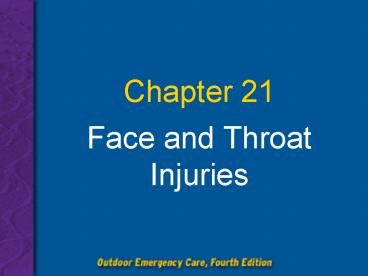Face and Throat Injuries - PowerPoint PPT Presentation
1 / 15
Title:
Face and Throat Injuries
Description:
Demonstrate the care of a patient with soft-tissue wounds of the face and neck. ... The airway, esophagus, and spinal cord can be damaged from penetrating injuries. ... – PowerPoint PPT presentation
Number of Views:76
Avg rating:3.0/5.0
Title: Face and Throat Injuries
1
Chapter 21
- Face and Throat Injuries
2
Objectives (1 of 2)
- List the steps in the emergency medical care of
the patient with soft-tissue wounds of the face
and neck. - List the steps in the emergency medical care of
the patient with injuries of the nose and ear. - List the steps in the emergency medical care of
the patient with a penetrating injury to the neck.
3
Objectives (2 of 2)
- List the steps in the emergency medical care of
the patient with dental injuries. - Demonstrate the care of a patient with
soft-tissue wounds of the face and neck. - Demonstrate the care of a patient with injuries
of the nose and ear. - Demonstrate the care of a patient with a
penetrating injury to the neck.
4
Anatomy of the Head
5
Landmarks of the Neck
6
Injuries to the Face
- Injuries about the face can lead to upper airway
obstructions. - Bleeding from the face can be profuse.
- Loosened teeth may lodge in the throat.
- If the great vessels are injured, significant
bleeding and pressure on the airway may occur.
7
Soft-Tissue Injuries
- Soft-tissue injuries to the face and scalp are
common. - Wounds to the face and scalp bleed profusely.
- A blunt injury may lead to a hematoma.
- Sometimes a flap of skin is peeled back from the
underlying muscle.
8
Care of Soft-Tissue Injuries (1 of 3)
- Assess the ABCs and care for life-threatening
injuries. - Follow proper BSI precautions.
- Blood draining into the throat can lead to
vomiting. Monitor airway constantly. - Take appropriate precautions if you suspect a
neck injury.
9
Care of Soft-Tissue Injuries (2 of 3)
- Cover exposed internal structures with sterile
moist dressings. - Return avulsed tissue, rinsed in saline, to its
normal position
10
Care of Soft-Tissue Injuries (3 of 3)
- Injuries around the mouth may obstruct the
airway. - Collect and return any amputated parts with the
patient.
11
Injuries of the Nose
- Blunt trauma to the nose can result in fractures
and soft-tissue injuries. - Cerebrospinal fluid coming from the nose is
indicative of a basal skull fracture. - Bleeding from soft-tissue injuries of the nose
can be controlled with a dressing.
12
Injuries of the Ear
- Ear injuries do not usually bleed much.
- Place a dressing between the ear and scalp when
bandaging the ear. - For an avulsed ear, wrap the part in a moist,
sterile dressing. - If a foreign body is lodged in the ear, do not
try to manipulate it.
13
Facial Fractures
- A direct blow to the mouth or nose can result in
a facial fracture. - Severe bleeding in the mouth, loose teeth, or
movable bone fragments indicate a fracture. - Fractures around the face and mouth can produce
deformities. - Severe swelling may obstruct the airway.
14
Blunt Injuries of the Neck
- A crushing injury of the neck may involve the
larynx or trachea. - A fracture to these structures can lead to
subcutaneous emphysema. - Be aware of complete airway obstruction and the
need for rapid transport to the hospital.
15
Penetrating Injuries of the Neck
- They can cause severe bleeding.
- The airway, esophagus, and spinal cord can be
damaged from penetrating injuries. - Direct pressure should control most bleeding.
- Place an occlusive dressing on a neck wound.
- Arrange for prompt transport and treat for shock.

